A Chance at a Bill Credit Awaits You
by Preston Knight, Communication Manager
SVEC recently returned more than $4.4 million in capital credits to members.
How about a few thousand more?
A drawing for bill credits is a way to entice members to participate in the cooperative’s annual meeting, which you can do now, even though the event is not until Thursday, Aug. 7. By filling out your proxy for the meeting, which
basically serves as your RSVP, or registering to receive a call for it, you are automatically entered to win a $250 bill credit.
Member participation is important to allow the cooperative to reach its meeting attendance requirements, per SVEC bylaws. This keeps cooperative business flowing, such as a given year’s director elections and amendments to bylaws.
This year, the annual meeting will be held via telephone at 7 p.m. Aug. 7. Three director seats comprise the election — each one featuring an uncontested incumbent candidate on the ballot — and no major bylaw changes are proposed.
Your participation is welcomed, nonetheless. It could pay off in a big way for you. •
Two Ways to Enter the Drawing for a $250 Bill Credit
To enter by meeting proxy: Return the proxy you received in the mail or email in June.
CONTACT US
Mailing Address
180 Oakwood Drive, Rockingham, VA 22801
Phone Web
800-234-7832 • svec.coop
Email svecpr@svec.coop
Local Pages Editor Preston Knight
Local Pages Designer Ashley Kreis
If you would like to unsubscribe from receiving the print edition of Cooperative Living, email svecpr@svec.coop with your home address.
To enter by meeting registration: Visit
during regular business hours.
Ways to Save This Summer
Summer has arrived, which typically means higher temperatures that lead to higher-than-normal electric bills. This is especially true this year, as an increase at the wholesale-power level led to a rate adjustment for SVEC members in June, while SVEC also has a seasonal summer block rate through September for residential members. If you use over 800 kWh during your billing cycle, you are charged more for this electric consumption than at other times throughout the year.
You have control over how much electricity you use. Here are a few ways you can save in the summer heat:
• Reduce the use of your air conditioning system, turning it to 78 degrees, or at minimum, the warmest level that keeps you comfortable.
• Turn off all unnecessary lights.
• Close curtains and blinds to keep sunlight out.
• Turn off ceiling fans when you leave the room.
• Seal any air leaks around doors and windows.
• Use less hot water in any task, from laundry loads to shortening the length of showers.
Rodeo Teams Impress at Annual Showcase
by Preston Knight, Communication Manager
An SVEC-record six linemen, across two three-man teams, garnered awards at this year’s Gaff-n-Go Rodeo, capping off weeks of training for the annual showcase.
The rodeo, held May 16-17 outside of Richmond, features hundreds of participants from various utilities across the country. They perform multiple timed tasks, with the top three finishers in each event receiving recognition.
“It’s strong competition. If you’ve placed in this rodeo, you’ve really accomplished something,” SVEC President and CEO Greg Rogers says. “I’m proud of our guys.”
SVEC’s two journeymen teams, which are categorized in the industry as the most experienced of the rodeo participants, brought home the following awards:
• 1st place Journeyman Hurtman Rescue: Alec Gutt, Kaleb May and Tim Wright
• 3rd place Journeyman Hurtman Rescue: Tyler Campbell, Jacob Moyer and Cole Shaffer
• 3rd place Journeyman 15KV Fuse Coordination: Gutt, May, Wright
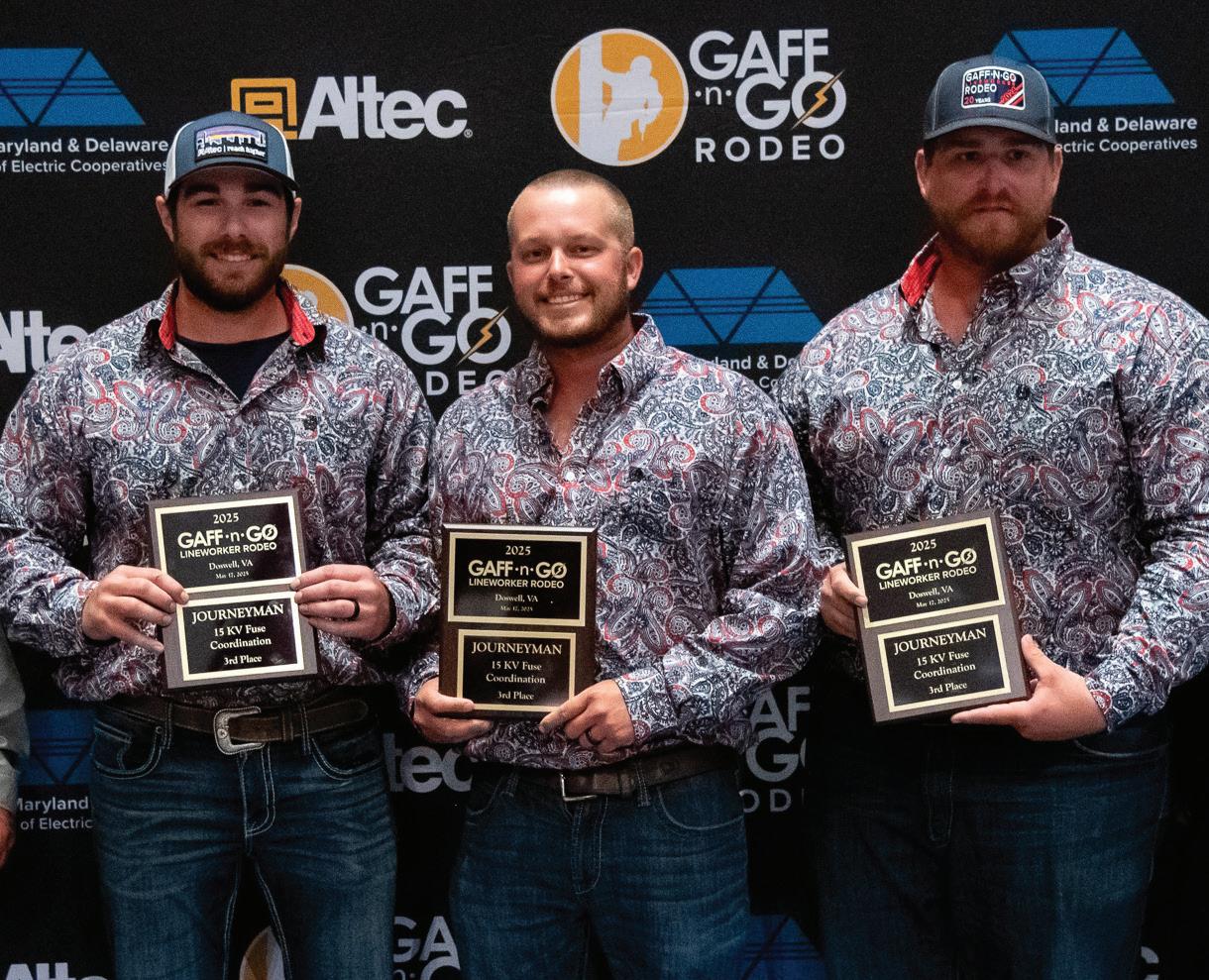


Among those winners, Campbell is a name that might stick out. He returned to SVEC a few months before the rodeo, after an extended absence following an electrical contact incident in April 2024. The previous year’s rodeo team, which would have been Campbell’s first as a participant, dedicated its performance to him wearing “Climbing for Tyler” shirts.
This year, Campbell and his wife, Danae, addressed the full rodeo crowd at a banquet following the day’s festivities.
“I’m blessed to be alive. I’m blessed to continue doing the work that I love,” he said. “Do not take anything for granted.” •






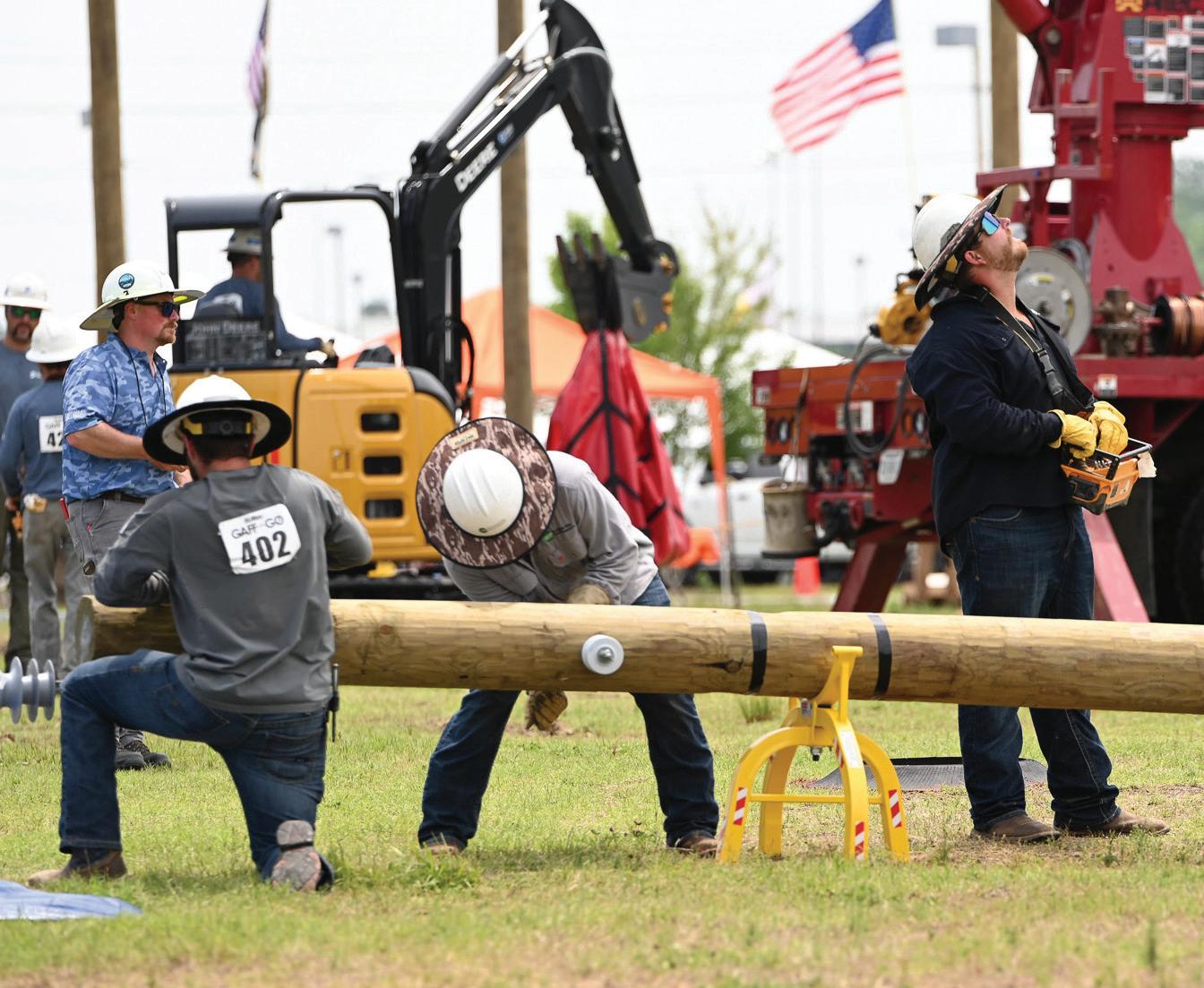
Scene Stealers
This group might be unseen. Their work? It’s everywhere.
by Preston Knight, Communication Manager
As the saying goes, behind every great lineman is a great operations field service coordinator, or something like that.
OFSCs, as the position of operations field service coordinators are called internally, are the versatile behindthe-scenes workhorses for SVEC’s line crews as well as engineers. While some employees design, construct and maintain the electric distribution system, these operations coordinators are connecting all the dots in the process to bring service to co-op members, and much more.
“Effectiveness for this role hinges on a blend of proactive planning. After all, a plan without planning is a recipe for disaster,” says Jenny Tilburg, who was a long-time coordinator in Augusta County until recently moving into an engineering role. “Ultimately, an effective OFSC is a linchpin, ensuring smooth operations and minimizing disruptions.”
Across electric cooperatives, skillsets run the gamut as office staff and field
personnel find common ground in the name of providing safe and reliable electric service. Usually at the core of all careers is an ability to communicate with multiple personality traits who have varied responsibilities.
OFSCs have a valid argument that they do it best.
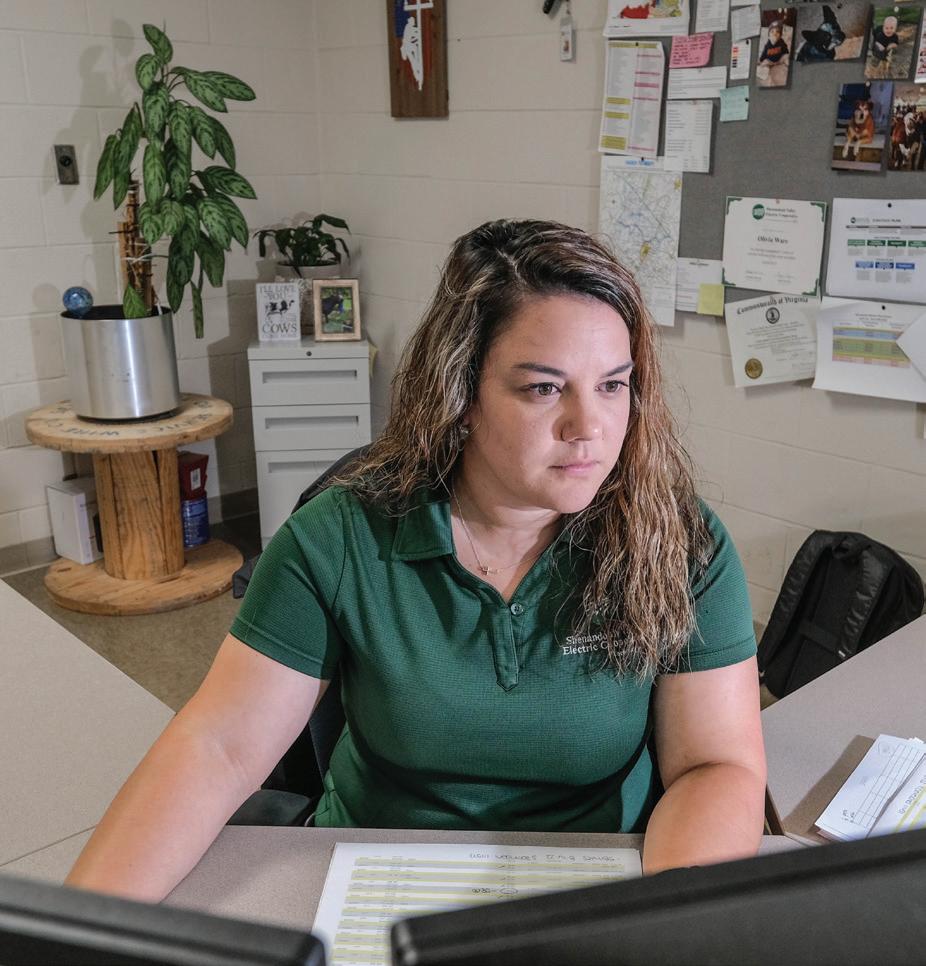
internal support for virtually all co-op departments.
“What I enjoy most about my job is being the ‘go-to support’ for both the engineers and linemen,” says Olivia Ware, a coordinator in Winchester. “I help keep everything organized and make sure the paperwork gets done. Without our role, a lot of things would come to a standstill.”
DETAILS, DETAILS, DETAILS
Each of SVEC’s five districts has at least one OFSC, responsible for handling project workflow for that office’s line crews and field engineers. For the former, they help reconcile miles driven in company vehicles for monthly reporting and manage vehicle maintenance needs. They work closely with the operations supervisor, who oversees each district’s line crew, to complete necessary steps for closing any job orders. The position also requires interactions directly with members and other external stakeholders. This goes with
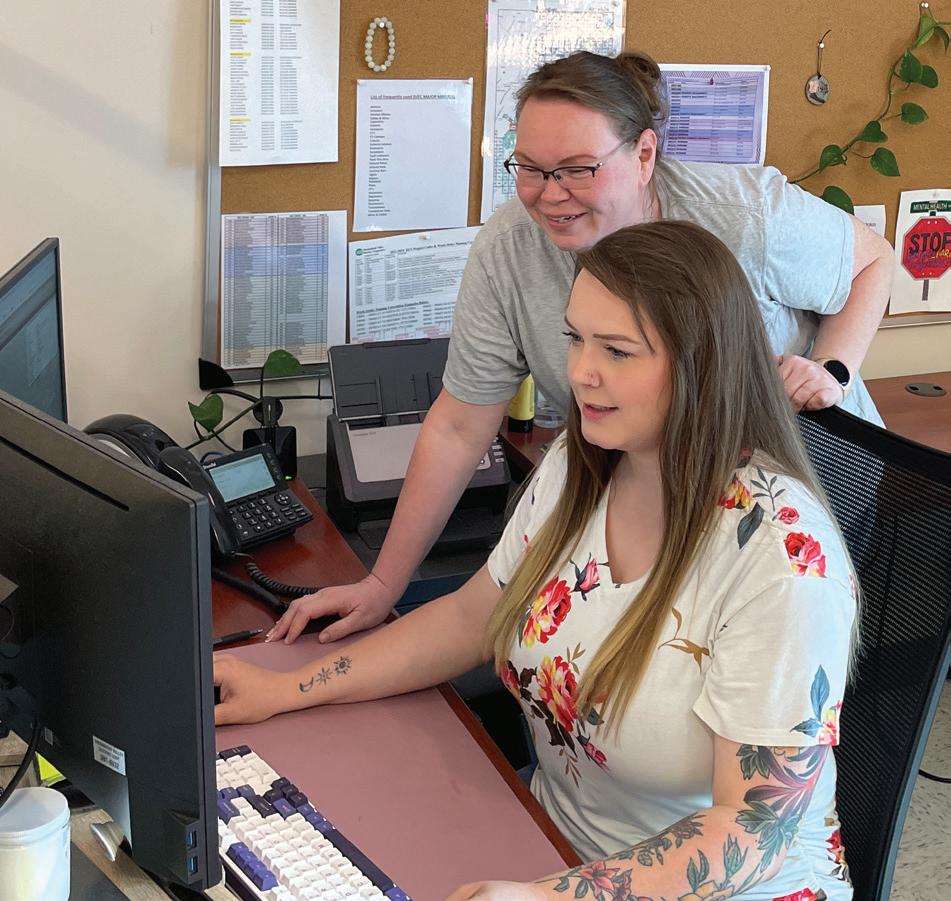
“There’s a satisfaction for me knowing our efforts help bring success and well-being to our members,” says Rachel Papotnik, an OFSC in Rockingham County. “I really enjoy working with our members, electricians and contractors to help them reach their end goal. I am also very fortunate to work with a wonderful group of likeminded people that strive to get the job done safely and efficiently.”
Tilburg says she appreciated facing new challenges daily, which kept the work “dynamic and engaging” while she was an OFSC.
“It’s nice to go home knowing all appointments have been completed, outages resolved, and everyone is safe and going home to their families.”
– Katie DeWarf, Winchester operations field service coordinator “
“For me, the rewarding aspect of this job lies in being part of something bigger than myself,” she says. “When things are rolling smoothly or some serious problem solving has gone in to making something work, knowing that my efforts directly contribute to the reliable delivery of service to our members provides a profound sense of purpose.”
OFSCs are the central point of coordination for field operations, acting as the conductor that ensures
power flows seamlessly, Tilburg says. The bulk of their work comes from a phone call a member makes to a member service representative. The information gathered gets printed to an OFSC as a service order that is then worked up and assigned to an engineer.
Engineers release staking sheets back to the OFSC, who confirms all necessary paperwork is intact, including payments, permits and inspections.
“Our address books and speed dials also include the county offices and those of other utilities when they are attached to poles,” Tilburg says. “When we run into something unexpected in the field, we are often in the crosshairs between our field crews and the other utility relaying important information for anything from a question about an area we are working to an emergency situation.”
This barely scratches the surface of all the job requirements. That’s why an effective OFSC is someone detail oriented and able to multitask, according to Katie DeWarf, a coordinator in Winchester.
A large screen monitor mounted on the wall over her shoulder shows a color-coded spreadsheet of ongoing work, which to an outsider might seem like an overwhelming presence hovering over you. DeWarf, like her coordinator associates, wouldn’t want it any other way.
“It’s nice to go home knowing all
appointments have been completed, outages resolved, and everyone is safe and going home to their families,” she says.
WORKING WITH ‘THE GUYS’
For an OFSC to be most effective, a close relationship with colleagues is essential. It’s easier said than done as these coordinators have one group of coworkers unlike any other.
“Working with linemen is great,” DeWarf says. “They have even given me the nickname ‘crew mom.’”
Ware says, “These guys quickly turn into family.”
Linemen do speak of a brotherhood among their ranks. OFSCs have earned their way into it.
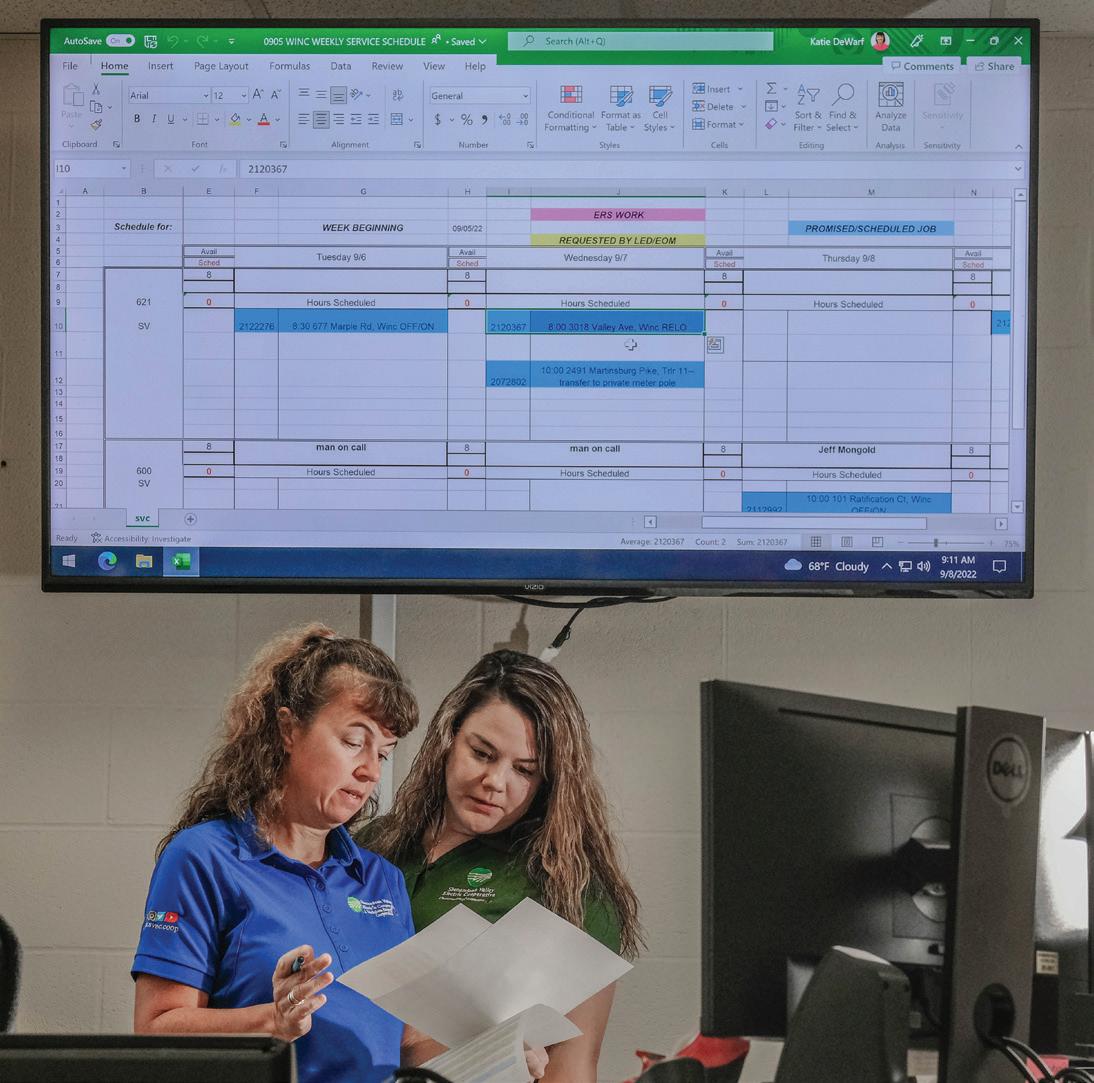
Today’s OFSCs are all women with a daily presence in the work lives of all-male line crews, who enjoy hard work and giving others a hard time.

“Nothing can be accomplished without a team effort. A lineman’s job is made that much simpler thanks to our OFSCs,” says Sam Lockhart, SVEC’s director of field and safety operations. “By extension, our members are on the receiving end of better service from the co-op.” Tilburg has fond memories of seeing the “crisp, white paperwork” she handed linemen early in the morning return as muddied and wet as the crews by day’s end. As quickly as she notices this sign of a good day’s work, she overhears familiar chatter about non-work topics, such as anniversaries or hunting excursions.
“Being around them provides a constant reminder of the dedication and hard work that underpins the reliable electricity we often take for granted and the fact that at the end of the day they are human,” Tilburg says.
But much the same goes for the value of an OFSC. Their own dedication and hard work should not be overlooked. If they were to suddenly disappear, co-op members would notice. Those who work on the front lines rely heavily on them.
Ware says, “It’s rewarding to know that what we do behind the scenes helps keep the whole operation running smoothly.” •

Come Fly with Me
Inside the basket: Meet the family ballooning over Bridgewater
by Lydia Weaver, Community Relations Specialist
Champagne and propane are jokingly known as a customary breakfast in the hot-air balloon world.
But if you’re fortunate enough, as I was, to fly with Star Ballooning of Bridgewater, the post-flight breakfast also includes homemade baked goods.
Camaraderie and smiles follow two balloon rides on a beautiful May morning, with conversations buzzing between crew members and the day’s riders (myself included), who have traveled from near and far for the experience. After every successful flight, there is a toast with champagne, coinciding with the sport’s French origins. Perhaps contradicting the luxury of champagne is the balloon’s necessary fuel for travel, propane, hence the “breakfast” of modern balloonists.
At Star Ballooning, there’s the complimentary addition of cookie, pastry or cake offerings, differing by the occasion or crowd, baked by crew and SVEC member Nancy Cornwell.
As a true family affair, Mark Miller, owner and pilot of Star Ballooning, is joined by his 2-year-old son and his dog, the company mascot, who are both chase vehicle experts, for the festivities. Along with them are Miller’s wife and several SVEC members, like his mother, uncle and more “balloon family,” making up the crew who contributes to the business’ success.
Miller says you need at least three crew members on the ground for a flight, but they generally have more because it’s so fun to do together. Notable jobs include blowing up the balloon with fans, unpacking and packing up the balloon, babysitting the youngest crew member, and following the balloon in the chase vehicle to meet up for landings. Luckily, there’s an app with a tracker for that last task.

READY FOR TAKEOFF
Miller’s balloon tours average about five miles, with speeds mostly kept under 10 or 20
mph, depending on wind currents. However, he has also piloted greater distances, journeys known as long jumps, flying over 100 miles and reaching speeds up to 82 mph.
Star Ballooning has offered tours since 2013, and Miller has now piloted over 400 flights. He earned his student pilot license for ballooning in high school. Inspired by an uncle, Steve Shirkey, who is a pilotturned-crew member for Star Ballooning, Miller began learning the ropes, literally, from a young age by assisting on the ground.

“I loved crewing growing up,” Miller says, adding you only need to be 16 years old to pilot a solo flight and 14 to get a student license.
And though he’s the sole pilot at Star Ballooning, he occasionally crews for others. His network of friends in the industry assists each other as needed, like his second pilot on this May morning.
Miller says he wishes more people knew the sport is considered safe. According to data from the National Transportation Safety Board, it’s safer than airplanes and

car rides. Reiterating the safety precautions taken for each flight, Miller says all balloon parts and equipment must meet Federal Aviation Administration regulations, just like airplanes, and be certified for aircraft use.
“It’s not scary,” Miller says. “And it’s safe. People have a perception that it’s risky or the landing is really rough. It’s really nothing to it.

“A lot of times, people are nervous in the beginning, and afterwards, after landing, I’ve completely won them over and they want to come back.”
ALONG FOR THE RIDE
Tony and Barbara Martinez, and their son, ventured south, leaving their Loudoun County home at 3 a.m. to make the 6 a.m. departure time for their balloon ride. The balloon they flew in is named Theia, after the goddess of clear blue skies. Flying to celebrate Barbara’s birthday, they say they would absolutely do it again.
“Completely different than what I expected. It was so calm. Smooth ride. It’s just very peaceful up there,” Tony Martinez says.
“As you liftoff, you don’t realize how graceful and how smooth takeoff is. Even the landing. The landing was so easy. It was nothing to it.”
Since I had the pleasure of riding in the second balloon that morning, called Shenandoah, derived from both the location and its Algonquian meaning of “beautiful daughter of the stars,” I can

concur. The balloon ride was smoother than any airplane I’ve been on and felt safer than my one helicopter experience. Hearing both the pilot and a first-time rider say, “there’s nothing to it,” proves how confident just one ride can make you.
Besides the expected bird’s-eye view of the scenic Shenandoah Valley, the other breathtaking sight included the balloons themselves. Draped over the ropes are vibrant color schemes that stand out both on the ground

and against the blue sky. Their grandeur cannot go unnoticed.
“At first when you see the balloon itself, I think the most shocking part is the size of it,” Tony Martinez says.
While the two balloons of Star Ballooning aren’t considered large by industry standards, the Shenandoah can carry six passengers in addition to the pilot. With so few in the basket for a shared hot-air balloon ride, these tours feel intimate, despite how massive the balloon may seem when standing beside it.
For Miller, it’s about sharing his love of ballooning with others.
“[I enjoy] sharing the experience and seeing people’s expressions,” he says. “I obviously know what it’s like and really enjoy it, but sharing it with someone, and they just fall in love, too, [that’s my favorite part].” •
For more information about Star Ballooning tours, visit starballooning.com.


SUMMER TIPS^





WHAT IS BEAT THE PEAK?
The amount of electricity SVEC members collectively use varies, even from hour to hour. But there are certain times when electricity use spikes as members all use more power at the same time. These high-use periods are called peaks, and it costs the co-op more to purchase and distribute electricity at these times.
SVEC seeks to “beat” these peak periods of high electricity demand by encouraging widespread energy conservation during them. We notify participants via text and/or email when a high demand period for electricity will occur, enabling members to prepare accordingly.
Peak alerts are generally during the hottest and coldest days of the year. Over the summer, we often call for a Beat the Peak alert from 4-8 p.m. as people return home from work while temperatures are still high.
HOW DOES SOMEONE BEAT A PEAK THIS SUMMER?
Reduce the use of your air conditioning system, turning it to 78 degrees. Every degree matters as your unit is trying to overcome the heat outside to meet your desired setting inside. Please be comfortable in your home as you beat peaks.
Peak hours in the summer months are from 4-8 p.m.
You should also turn off all unnecessary lights, close the curtains to keep sunlight out and delay the use of major appliances, such as the dishwasher, washing machine or oven, during peak times.
WHY SHOULD I JOIN?
SVEC pays the highest rates for electricity during these peak demand periods. Whatever amount of electricity SVEC needs to buy during these peak times over the course of a year will impact rates. The solution is to get as many members as possible on board to use less electricity during those peaks.
The co-op works hard to manage costs. Beat the Peak is an easy way for members to collectively do their part when it suits them. It is a voluntary program. You can be as active a Beat the Peak participant as you’d like, opting out from receiving alerts at any time. •
How to Join:
Sign up for text and/or email alerts at svec.coop/BTP.
